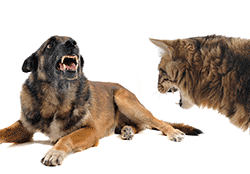Mixing cats with other animals
Cats are social animals and with the right introductions and timing, they can live happily with other pets

As with mixing cats together, success with other animals depends a great deal on the introduction. Most cats prefer to have free run of the household and may not appreciate other animals unless they have been together from an early age. Introducing a new cat to a household with other animals, or introducing new animals into a house with an existing cat needs to be done slowly and carefully. If done properly they should get along, or at least tolerate each other, and they may even begin to enjoy each others company.
Introducing cats and dogs
Despite the stereotype, cats and dogs usually get along fine, in many cases an established cat will get along with a dog more than it would another cat. This lack of conflict can be found with many different animals and is usually because the two animals are not instinctively competing for breeding ground or food. A successful introduction of cats and dogs relies on the dog's behaviour rather than the cat's. Dog owners should be in complete control of their dog, whilst cats will generally do as they please, which means the only controllable element in a meeting is the dog.
Controlling your dog
The meeting should happen when your dog is relaxed and not excitable, a good time might be when your dog is tired - after exercise for example. You should gently hold your dog and be ready to prevent him/her from jumping or running at the cat, use a lead if necessary. The next step is to allow your cat to enter the room and 'discover' the dog. There will be some intense staring between the two animals whilst they work each other out. It is up to you to restrain and keep control of your dog, let your dog know that chasing or barking is not allowed. Try and entice your cat nearer by using some treats or toys so that eventually the two animals get a chance to smell each other. You may need to carry out a few of these meetings before your cat and dog can be left unrestrained.

Make sure your dog knows that your cat has a higher rank
Cats are always in charge
If your dog gets too close for your cats liking, your cat may swipe at the dog followed by hissing or arching of the back. The important thing here is your dogs reaction which should be to back off, if your dog thinks this is a game and becomes excitable you should restrain your dog or issue a telling off. Because of the nature of cats and dogs, a harmonious household can only be achieved if the cat holds dominance over the dog.
Cats and aquarium fish
As long as your indoor aquarium has a hood there is no danger of your cat trying to get your fish, although there may be some interest in their movement. What can be a disaster is your cat jumping onto a flimsy aquarium hood and falling in the tank, along with the tanks lights. Cats are likely to jump onto fish tanks because the fish are interesting, the hood is nice and warm, and the location offers a nice high viewpoint.
Cats and pond fish
Pond fish are not protected by a hood and may be of interest to your cat. In most cases the fish will be wise enough to avoid your cat, but the reverse can happen - if fish learn to come to the surface for food when a human figure hovers over the pond, they may do the same when a cat hovers over. You can cover your pond with pond netting although this is a bit unsightly, but the best methods are outlined in our article on cat deterrents. If you do find any fish dead in your garden bear in mind it is just as likely to be a heron, or even another cat, than your own cat.
Other animals
Apart from dogs, most other popular pets could be considered as prey items for a cat (fish, birds, rabbits, hamsters etc..) so mixing becomes a little complicated. Most cats will accept other pets once they are used to their smell and familiarity. It is even possible for cats and birds to get along, but expecting this from a cat who has not lived with birds before may be a bit too much. Larger animals like rabbits are a bit easier to introduce as they are of similar size. The key to mixing is always to provide a supervised, slow introduction and never leave the animals alone until you are absolutely sure they get along. Once animals realise they are not a threat to each other they often appreciate the familiarity of each other - in nature the presence of other animals known to be friendly is a good sign that the immediate environment is safe.













